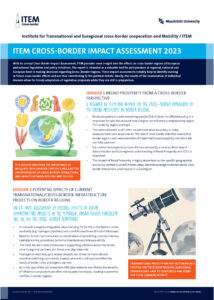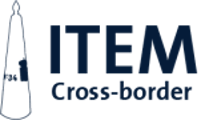The Cross-Border Impact Assessment 2023, compiled by the interdisciplinary team of researchers at the Institute for Transnational and Euregional cross-border cooperation and Mobility / ITEM, aims to map the effects of European and national legislation and policies on border regions. The researchers presented their dossiers in a video pitch during the Annual Conference in The Hague. This year’s report consists of five dossiers covering topics as diverse as Broad Prosperity and Cross-border Infrastructure. The report is intended to be a valuable tool for policymakers at regional, national and European level to visualise the effects on the border region and cross-border cooperation.
The dossiers
Worldwide, the idea of measuring and promoting prosperity in the broad sense at regional and national level is gaining attention. This goes beyond traditional economic development, as in the Sustainable Development Goals of the United Nations and in the Netherlands with the concept of ‘Broad Prosperity’. But border regions in particular come off particularly badly. We know that for broad prosperity, the region must be considered in context. However, the national border is still often an administrative boundary in many measurements and assessments. This is the subject of the first dossier EURegional Barometer: broad prosperity from a cross-border perspective that focuses on the cross-border dimension of broad prosperity in border regions. What do we already know, what is still missing and what should be taken into account?
The second dossier Transnational Infrastructure projects: Ambitions, sectors, instruments and effect on border regions focuses on the currently impressive plans for cross-border infrastructure projects that cross the borders of the Netherlands, Belgium and Germany. In the case of hydrogen infrastructure, waterways and rail infrastructure, there is an understanding that due to climate change ambitions and legal obligations, this kind of infrastructure needs to be realised in a relatively short time frame. Or, as in the case of the Einstein telescope in the Meuse-Rhine Euregion, spatial planning decisions, permits and subsidies need to be synchronised across borders to avoid damaging delays and shortcomings. This border impact dossier will examine the various projects and ambitions and the central question is aimed at uncovering the missing link: do we have the right tools to tackle these kinds of cross-border challenges? And do we know which partner has the right cross-border competences? Are there certain obstacles that can be detected as common problems for the mentioned infrastructure projects? And what are innovative tools to facilitate and accelerate large cross-border infrastructure projects?
The third dossier Kinderzuschlag and Kindgebonden budget: The border worker caught in the middle? deals with the entitlement to the German Kinderzuschlag and the Dutch kindgebonden budget which is based on a residence criterion. A cross-border worker may therefore be ineligible for either benefit in certain cases. However, until 1 July 2022, non-residents, e.g. residents of the Netherlands working in Germany, could also claim Kinderzuschlag, i.e. the Zuschlag was exportable across the border. From 1 July 2022, Germany will no longer qualify this Kinderzuschlag as a family benefit but as a social benefit with the result that it will no longer be exported by Germany. This has adverse consequences for frontier workers; especially lower-income frontier workers. This dossier highlights the need for more cross-border cooperation and communication between neighbouring countries in the application and interpretation of national social security legislation and European social security legislation.
Acute care is facing challenges due to an ageing population, a rising demand for emergency care and a shortage of healthcare professionals. In response to these pressing issues, the Dutch health minister has proposed a policy aimed at creating a future-proof organisation for acute care in the Netherlands. It is noted that providing all forms of acute care throughout the Netherlands, especially in the border regions, may not be feasible. This has raised concerns about the impact of the proposal on the availability of acute care in border regions. Concentration measures and closing emergency departments may result in patients having to travel long distances for (acute) care. Can these policy goals of ensuring quality and accessibility of acute care in some border regions be achieved in cooperation with neighbouring countries, closer to where patients live? Can we consider providing acute healthcare from a 360-degree perspective beyond national borders? Can we draw valuable lessons from the Covid-19 pandemic, especially regarding care coordination, perceived pressure on intensive care capacity and the value of cross-border cooperation? This fourth dossier Future-proof acute care in the Netherlands: 360° cross-border perspectives on future-proof acute care in the Netherlands explores these questions and assesses what the impact of these policies would be on the prosperity of border regions.
The fifth and final dossier Public Transportation in the Euregion Meuse-Rhine (student dossier) concerns a study carried out as part of a PREMIUM project by a multidisciplinary student team: Public transport in the Meuse-Rhine Euregion. Based on the Meuse-Rhine Euregion, and specifically the Drielanden (three countries) train, the students investigated the obstacles to cross-border public transport projects. By talking to public transport users, companies and policymakers, they compiled a good overview of the problems such projects generally face but also of possible solutions. For instance, they concluded that cross-border public transport in the EMR would greatly benefit from an EU-wide standard framework for CBPT projects to promote better coordination between stakeholders and streamline joint projects; more transparency and communication between transport operators and passengers; and harmonisation of cross-border infrastructure development. Moreover, cross-border public transport projects still receive insufficient funding and attention from government organisations, on which success depends heavily.
The Cross-Border Impact Assessment dossiers are chosen annually based on a survey of ITEM stakeholders and other interested parties. In addition, topics may also be highlighted in the context of ITEM’s day-to-day activities under the ITEM annual cycle. The dossiers again show the importance of testing for border effects, as is also mandatory in the Netherlands for new legislation and policies under the Policy Compass / Beleidskompas since 2022.
Watch the video pitch of the dossiers on YouTube
▶️ Read the summary of all border impact dossiers
▶️ Read the press release by Maastricht University
▶️ ITEM reflection: House of Representatives elections from a cross-border Perspective (Dutch)
▶️ Download the infographic (click on the picture below)


